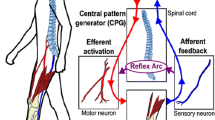Abstract
The research purpose was to improve the accuracy in identifying the prosthetic leg locomotion mode. Surface electromyography (sEMG) combined with high-order zero-crossing was used to identify the prosthetic leg locomotion modes. sEMG signals recorded from residual thigh muscles were chosen as inputs to pattern classifier for locomotion-mode identification. High-order zero-crossing were computed as the sEMG features regarding locomotion modes. Relevance vector machine (RVM) classifier was investigated. Bat algorithm (BA) was used to compute the RVM classifier kernel function parameters. The classification performance of the particle swarm optimization-relevance vector machine (PSO-RVM) and RVM classifiers was compared. The BA-RVM produced lower classification error in sEMG pattern recognition for the transtibial amputees over a variety of locomotion modes: upslope, downgrade, level-ground walking and stair ascent/descent.
Similar content being viewed by others
References
YOUNG A J, SIMON A M, FEY N P, et al. Intent recognition in a powered lower limb prosthesis using time history information [J]. Annals of Biomedical Engineering, 2014, 42(3): 631–641.
SUN J M, VOGLEWEDE P A. Powered transtibial prosthetic device control system design, implementation, and bench testing [J]. Journal of Medical Devices, 2014, 8(1): 011004.
LIU Z J, LIN W, GENG Y L, et al. Intent pattern recognition of lower-limb motion based on mechanical sensors [J]. IEEE/CAA Journal of Automatica Sinica, 2017, 4(4): 651–660.
ZHENG E H, WANG Q N. Noncontact capacitive sensing-based locomotion transition recognition for amputees with robotic transtibial prostheses [J]. IEEE Transactions on Neural Systems and Rehabilitation Engineering, 2017, 25(2): 161–170.
SHENG M, LIU S Q, WANG J, et al. Motion intent recognition of intelligent lower limb prosthesis based on GMM-HMM [J]. Chinese Journal of Scientific Instrument, 2019, 40(5): 169–178 (in Chinese).
WANG Y X, CHEN H, YIN Z, et al. Human action and road condition recognition based on the inertial information [J]. Journal of Biomedical Engineering, 2018, 35(4): 621–630 (in Chinese).
HUANG S, FERRIS D P. Muscle activation patterns during walking from transtibial amputees recorded within the residual limb-prosthetic interface [J]. Journal of Neuroengineering and Rehabilitation, 2012, 9: 55.
HARGROVE L J, SIMON A M, YOUNG A J, et al. Robotic leg control with EMG decoding in an amputee with nerve transfers [J]. The New England Journal of Medicine, 2013, 369(13): 1237–1242.
ZHAO X D, LIU Z J, CHEN L L, et al. Approach of running gait recognition for lower limb amputees [J]. Journal of Zhejiang University (Engineering Science), 2018, 52(10): 1980–1988 (in Chinese).
SIMON A M, INGRAHAM K A, SPANIAS J A, et al. Delaying ambulation mode transition decisions improves accuracy of a flexible control system for powered knee-ankle prosthesis [J]. IEEE Transactions on Neural Systems and Rehabilitation Engineering, 2017, 25(8): 1164–1171.
KIM D H, CHO C Y, RYU J. Real-time locomotion mode recognition employing correlation feature analysis using EMG pattern [J]. ETRI Journal, 2014, 36(1): 99–105.
MILLER J D, BEAZER M S, HAHN M E. Myoelectric walking mode classification for transtibial amputees [J]. IEEE Transactions on Biomedical Engineering, 2013, 60(10): 2745–2750.
YOUNG A J, HARGROVE L J, KUIKEN T A. Improving myoelectric pattern recognition robustness to electrode shift by changing interelectrode distance and electrode configuration [J]. IEEE Transactions on Biomedical Engineering, 2012, 59(3): 645–652.
WANG H T, LI T, HUANG H, et al. A motor imagery analysis algorithm based on spatio-temporal-frequency joint selection and relevance vector machine [J]. Control Theory & Applications, 2017, 34(10): 1403–1408 (in Chinese).
ZHU B L, ZHU W Y, ZHU Z Q, et al. Application of bat algorithm based on statistical characteristics in spectrum allocation of cognitive radio [J]. Systems Engineering and Electronics, 2018, 40(2): 441–446 (in Chinese).
WANG J H, ZHANG L, SHI C, et al. Task allocation modeling and solving algorithm for equipment support using DLS-BCIWBA [J]. Systems Engineering and Electronics, 2018, 40(9): 1979–1985 (in Chinese).
GUO X, WANG L, XUAN B K, et al. Gait recognition based on supervised Kohonen neural network [J]. Acta Automatica Sinica, 2017, 43(3): 430–438 (in Chinese).
CHENG J, CHEN X, PENG H. An onset detection method for action surface electromyography based on sample entropy [J]. Acta Electronica Sinica, 2016, 44(2): 479–484 (in Chinese).
LIU L, YANG P, LIU Z J. Lower limb locomotion-mode identification based on multi-source information and particle swarm optimization algorithm [J]. Journal of Zhejiang University (Engineering Science), 2015, 49(3): 439–447 (in Chinese).
Acknowledgment
The authors would like to thank the National Center for Rehabilitation AIDS and Five graduate students from Hebei University of Technology
Author information
Authors and Affiliations
Corresponding author
Additional information
Foundation item
the Center Plain Science and Technology Innovation Talents (No. 194200510016), the Science and Technology Innovation Team Project of Henan Province University (No. 19IRTSTHN013), and the Key Scientific Research Support Project for Institutions of Higher Learning in Henan Province (No. 18A413014)
Rights and permissions
About this article
Cite this article
Liu, L., Yang, P., Liu, Z. et al. Prosthetic Leg Locomotion-Mode Identification Based on High-Order Zero-Crossing Analysis Surface Electromyography. J. Shanghai Jiaotong Univ. (Sci.) 26, 84–92 (2021). https://doi.org/10.1007/s12204-020-2249-1
Received:
Accepted:
Published:
Issue Date:
DOI: https://doi.org/10.1007/s12204-020-2249-1
Key words
- intelligent prosthesis
- surface electromyography (sEMG)
- relevance vector machine(RVM)
- high-order zero-crossing
- bat algorithm (BA)
- locomotion-mode identification




